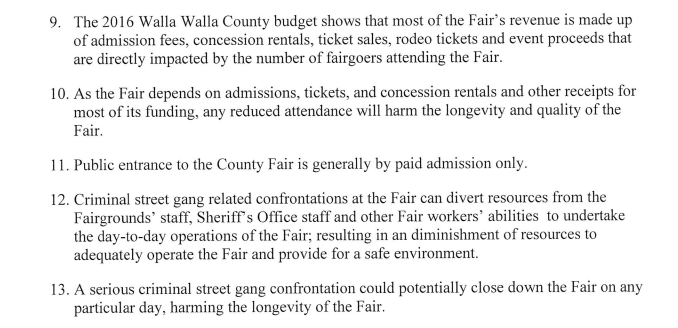The Pen Is Mightier Than The Sword
Not many First Amendment cases get filed. The vast majority—maybe 99 percent—get dismissed.
But ours didn’t. Last week we tried an important First Amendment case in the federal courthouse in Richland.
Some background:
Our client went to the Walla Walla Fair. She was wearing this hat:


In some ways the case was about the hat. But it was also about a whole lot more.
It was about our client. When she was growing up she didn’t have enough money to go to the Fair.
It was about the Fair. The Fair has been around for over 150 years. It’s where the community gathers. It draws every type of person that lives in Walla Walla:
Young and Old
White and Brown
Democrats and Republicans
PHDs and GEDs
Pro-Choice and Pro-Life
Because she wasn’t able to go as a kid our client was excited to attend with her husband and stepson.
Back in 2016 Walla Walla enacted an Ordinance and written Dress Code. One of the reasons they enacted it was to make sure the Fair provided a welcoming, family friendly venue for all members of the community.
But the Fair also had its mind on its money. And its money on its mind.
Here are some of the “findings” that supported enactment of the Ordinance:


The Dress Code has a whole section on what it calls Outlaw Motorcycle Gangs. One of the sections was titled “Amigos.”
The Amigos are a motorcycle club that has a chapter in Walla Walla. And the Dress Code specified that anything with the initials SYLA could not be worn to the Fair.
[SYLA stands for: Support Your Local Amigos]
Our client wore that hat because her husband was in the Amigos. Because the club was important to him, it was important to her.
She had seen the way law enforcement in Walla Walla had treated the Amigos. Law enforcement had posted-up at charity events just hoping to catch someone doing something wrong.
The way law enforcement acted made her feel bad. She didn’t like being treated that way. And didn’t like the insinuation that her husband was a gang member just because he rode a motorcycle.
One of the big problems with the Dress Code was not just that it prohibited people like our client from wearing something as innocuous as a baseball had with the letters SYLA on it, but it also was so complicated that none of the deputies working the Fair understood it.
So our client gets to the Fair. And she wants to send a message to a very targeted audience: law enforcement.
She wanted to make a couple of points:
The way motorcycle clubs in general were treated by law enforcement was unfair.
The way the Amigos were treated by Walla Walla law enforcement was unfair.
It was unfair to treat her or her husband like gang members.
She made those points in two ways. One by wearing the hat. And the other by wearing a t-shirt that had this on the front:


She and her husband and her stepson were at the Fair for about an hour. They were having a great time. It felt good to be part of the community. Then, from out of nowhere, she heard a deputy yell at them.
Six or seven deputies approach. Everyone’s looking at her. And her husband. And her stepson.
Deputies tell her she can’t wear the hat. It violates the Dress Code. She has to leave.
She’s confused and angry. She leaves. She re-groups. She and her husband and stepson come back to the Fair.
But what those deputies did wasn’t fair. They say you can’t fight city hall. But that’s exactly what she did. She filed suit because what the County did violated her First Amendment rights.
By the County’s own admission money was a factor in its decision to pass the Dress Code Ordinance. So maybe it wasn’t really about concern for public safety.
Sometimes credibility is assessed by what people do. Other times it’s assessed by what they don’t do.
And you know what the County didn’t do? The County didn’t have a policy about weapons at the Fair. In fact, deputies admitted that if someone wanted to carry an assault rifle into the Fair they could.
SYLA is prohibited. AK-47 is allowed. That begs the question, doesn’t it. Did concern over public safety justify suppressing Free Speech?
In Walla Walla was the pen (SYLA) really more of a threat to public safety at the Fair than the sword (an AK-47)?
The County didn’t really like that formulation. Or that issue. So it offered a parade of horribles about motorcycle clubs.
Stuff going back to the 1970s. And from all over the world.
But the bad acts of a few bikers in Sweden or Montreal or even Texas aren’t enough to justify the curtailing Free Speech in Walla Walla.
One of the witnesses for the County was a Seattle Police Department detective. He spent a lot of his time investigating gangs.
On cross examination I asked him what makes a gang a gang. He said three or more people with a common name or clothing who commit crimes.
Here’s the essence of the questions and answers that followed:
Q: How long have you been at the Seattle Police Department?
A: About 23 years.
Q: The DOJ investigated SPD?
A: True.
Q: It determined that the SPD engaged in a pattern of using excessive force?
A: I’m not sure about that…maybe.
Q: And that it utilized policies and practices could result in bias against minorities?
A: I guess so.
Q: It determined that the SPD’s pattern and practice violated the Constitution and federal law?
A: Well, yes.
Q: The Seattle Police Department entered into a “consent decree” with the federal government?
A: Yes, sir.
Q: SPD has been under DOJ supervision since 2012?
A: That’s about right.
Q: SPD filed a motion to remove parts of the decree related to use of force?
A: I think so.
Q: SPD then withdrew the motion because the community was not ready for the SPD to be released from any DOJ oversight?
A: I’m not sure about that.
Q: How many SPD officers have been arrested or charged with crimes in the past five or six years?
A: I’m not sure. [You may want to Google this question yourself—the results are pretty rich.]
Q: Do you consider the SPD a gang?
A: No.
Q: Why not? Because committing crime isn’t a “primary” activity of the SPD?
A: That’s right.
I walked back to counsel’s table. It was like all the air had been sucked out of the room.
We argued that if community members aren’t welcome to express their views–especially views that may be unpopular with law enforcement and local government–the Dress Code is not only inconsistent with the purpose of the Fair, but also inconsistent with the Constitution.
And how can a dress code be enforced in a way that doesn’t infringe on rights if law enforcement doesn’t even understand it?
The Court has requested additional briefing on some legal issues. It’s due October 31st. We expect a ruling on the Constitutionality of the Dress Code either late this year or early next year.
Myers & Company
Personal Injury Attorneys
© 2024. All rights reserved.


